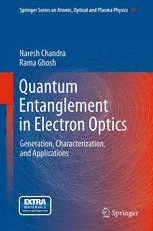Table Of ContentSpringer Series on Atomic, Optical and Plasma Physics 67
N. Chandra
R. Ghosh
Quantum
Entanglement
in Electron Optics
Generation, Characterization,
and Applications
SpringerSerieson
atomic, optical, and plasma physics
67
Editor-in-Chief: G.W.F. Drake
Department of Physics
U niversity of Windsor
401 Sunset, Windsor
N9B3P4 Ontario
Canada
Editorial Board: U we Becker, Fritz-Haber-Institut, Berlin, Germany
Philip George Burke, Q ueen’ s U niversity, Belfast, Ireland
Robert N Compton, Oak Ridge National Laboratory, Oak Ridge, U SA
M.R. Flannery, Georgia Institute of Technology, Atlanta, U SA
Charles J. Joachain, U niversite´Libre Bruxelles, Bruxellas, Belgium
B.R. Judd, The Johns Hopkins U niversity, Baltimore, U SA
Peter Lambropoulos, Foundation of Research and Technology-Hellas
(F.O.R.T.H.), Heraklion, Greece
Gerd Leuchs, Friedrich-Alexander-U niversitä t Erlangen-Nürnberg,
Erlangen, Germany
Pierre Meystre, The U niversity of Arizona, Tuscon, U SA
SpringerSerieson
atomic, optical, and plasma physics
TheSpringerSeriesonAtomic,Optical,andPlasmaPhysicscoversinacompre-
hensivemannertheoryandexperimentintheentirefieldofatomsandmolecules
andtheirinteractionwithelectromagneticradiation.Booksintheseriesprovide
arichsourceofnewideasandtechniqueswithwideapplicationsinfieldssuchas
chemistry,materialsscience,astrophysics,surfacescience,plasmatechnology,ad-
vancedoptics,aeronomy,andengineering.Laserphysicsisaparticularconnecting
themethathasprovidedmuchofthecontinuingimpetusfornewdevelopments
inthefield.Thepurposeoftheseriesistocoverthegapbetweenstandardunder-
graduatetextbooksandtheresearchliteraturewithemphasisonthefundamental
ideas,methods,techniques,andresultsinthefield.
PleaseviewavailabletitlesinSpringerSeriesonAtomic,Optical,andPlasmaPhysics
onserieshomepagehttp://www.springer.com/series/411
N. Chandra
R. Ghosh
Quantum
Entanglement
in Electron Optics
Generation, Characterization, and Applications
With 23 Figures
123
N.Chandra
IndianInstituteofTechnology
Department of PhysicsandMeteorology
Kharagpur 721302 , West Bengal
India
[email protected]
R.Ghosh
c/o B.N.Panda
1/A--46(H.I.G.),Lingraj Vihar
P okhariput 751020 , Orissa
India
[email protected]
Additional material to this book can be downloaded from http://extra.springer.com
Password: 978-3-642-24069-0
SpringerSeriesonAtomic,Optical,andPlasmaPhysics ISSN1615-5653
ISBN978-3-642-24069-0 ISBN978-3-642-24070-6 (eBook)
DOI10.1007/978-3-642-24070-6
SpringerHeidelberg New York Dordrecht London
LibraryofCongressControlNumber: 2012944986
© Springer-Verlag Berlin Heidelberg 2013
This work is subject to copyright. All rights are reserved by the Publisher, whether the whole or part
of the material is concerned, specifically the rights of translation, reprinting, reuse of illustrations,
recitation, broadcasting, reproduction on microfilms or in any other physical way, and transmission
or information storage and retrieval, electronic adaptation, computer software, or by similar or
dissimilar methodology now known or hereafter developed. Exempted from this legal reservation
are brief excerpts in connection with reviews or scholarly analysis or material supplied specifically
for the purpose of being entered and executed on a computer system, for exclusive use by the
purchaser of the work. Duplication of this publication or parts thereof is permitted only under the
provisions of the Copyright Law of the Publisher’s location, in its current version, and permission
for use must always be obtained from Springer. Permissions for use may be obtained through
RightsLink at the Copyright Clearance Center. Violations are liable to prosecution under the
respective Copyright Law.
The use of general descriptive names, registered names, trademarks, service marks, etc. in this
publication does not imply, even in the absence of a specific statement, that such names are exempt
from the relevant protective laws and regulations and therefore free for general use.
While the advice and information in this book are believed to be true and accurate at the date of
publication, neither the authors nor the editors nor the publisher can accept any legal responsibility
for any errors or omissions that may be made. The publisher makes no warranty, express or implied,
with respect to the material contained herein.
Printed on acid-free paper
Springer is part of Springer Science+Business Media (www.springer.com)
“An expertis aperson
who hasmadeeverypossiblemistake
at leastonce.”
AlbertEinstein
14March 1879 -18April1955
Thisbookisdedicatedto allthosepatient
peoplewho taughtushowto read,write,
think,anddo scientificresearch.
Foreword
Quantum entanglementis one of the most intriguing phenomenain nature. In the
wordsofAlbertEinstein,itisa”spookylongdistanceinteraction”.Inessence,itis
theeffectoftheinstantaneousinteractionbetweentwoquantumobjectswhentheir
properties are described by quantum variables. The possible eigenvalues of these
variables are for a single object completely random. Their actual values become
determined by a corresponding measurement of the particular variable only. For
the case of an entangled pair of two quantum objects, however, the eigenvalue
of a particular variable of the second object will be completely determined by
the result of the measurement performed on the first object, although the values
associated with the second object are completely random, if its properties are
measured independently, which means not in coincidence with the measurement
ofthefirstone.Thisistheresultofthejointwavefunctionofanentangledpairof
quantumobjectspossessingjointquantumvariables.Moreover,eventheselection
oftheparticularquantumvariablebythemeasurementonthefirstobjectdetermines
thevariableandtheireigenvaluesofthesecondobject.Thisisevenincontradiction
with the laws of quantummechanics themselves, because the selected variable of
the ”spooky long distance interaction” does not exist in quantum mechanics - or
moreprecisely-accordingtoHeisenberg’suncertaintyprinciple.Thisisthereason
that Albert Einstein argued in the famous Einstein, Podolsky and Rosen (EPR)
paper that the variable must have an existence before its measurement which is
determined by so-called hidden variables. This is the basis of the longstanding
discussionbetweentheexponentsof”pure”quantummechanicsandtheexponents
of the so-called localrealistic theorieswith hiddenvariables.The outcomeof this
dispute is known. All measurements probing Bell’s inequality, a quantitative way
of distinguishing between the two theories, have shown that quantum mechanics
is right. One of the major problems in probing the validity of Bell’s inequality
was the variable to be chosen. EPR suggested in their Gedankenexperiment that
the position in ordinaryspace be taken. This is, however,even nowadaysstill not
feasible.Bohmsuggestedthespin ofthe electron,butdueto thefactthatthespin
oftheelectroncannotbeprobedbyaStern-Gerlachexperiment,thissuggestionhas
alsoneverbeenrealized.Instead,thepolarizationpropertiesofthephoton,whichare
ix

